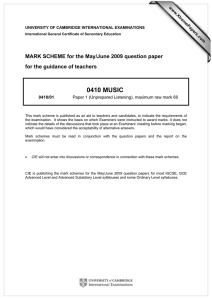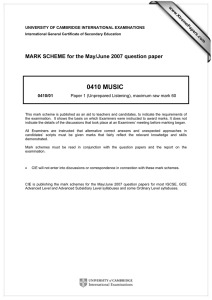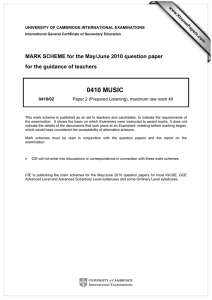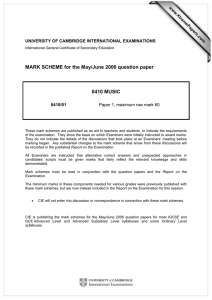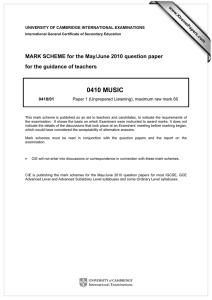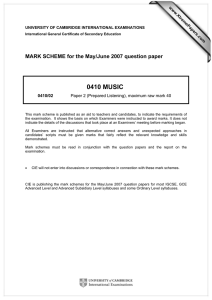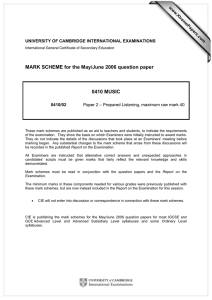0410 MUSIC MARK SCHEME for the May/June 2013 series
advertisement
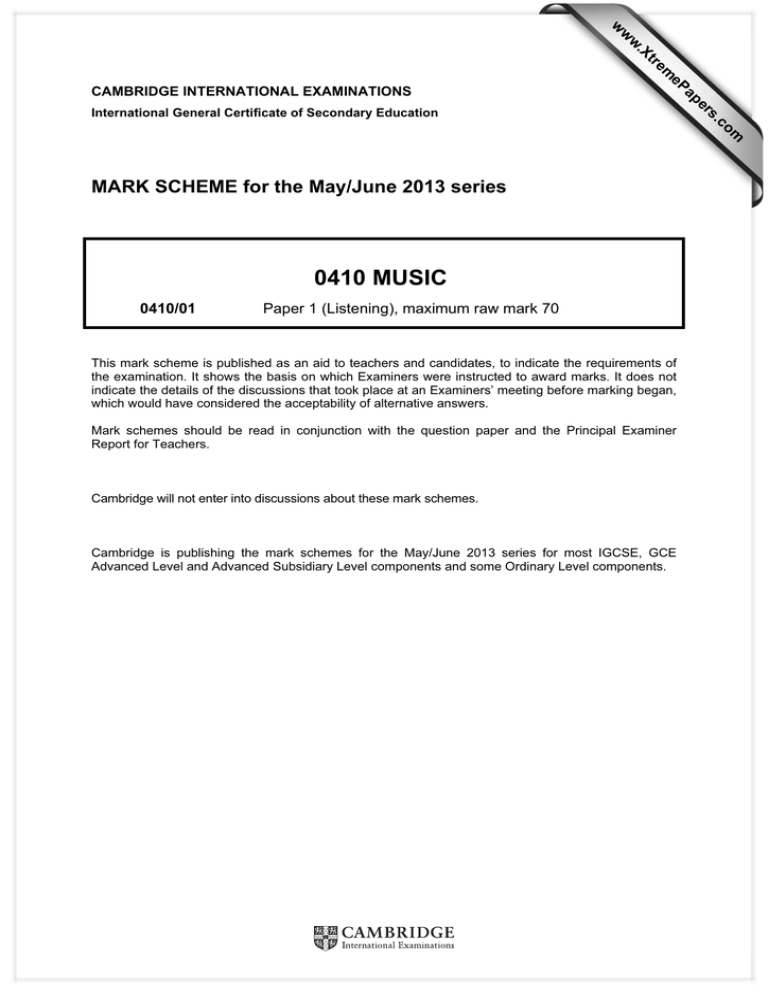
w w ap eP m e tr .X w CAMBRIDGE INTERNATIONAL EXAMINATIONS 0410 MUSIC 0410/01 Paper 1 (Listening), maximum raw mark 70 This mark scheme is published as an aid to teachers and candidates, to indicate the requirements of the examination. It shows the basis on which Examiners were instructed to award marks. It does not indicate the details of the discussions that took place at an Examiners’ meeting before marking began, which would have considered the acceptability of alternative answers. Mark schemes should be read in conjunction with the question paper and the Principal Examiner Report for Teachers. Cambridge will not enter into discussions about these mark schemes. Cambridge is publishing the mark schemes for the May/June 2013 series for most IGCSE, GCE Advanced Level and Advanced Subsidiary Level components and some Ordinary Level components. om .c MARK SCHEME for the May/June 2013 series s er International General Certificate of Secondary Education Page 2 Mark Scheme IGCSE – May/June 2013 Syllabus 0410 Paper 01 Music A1 1 What is the solo instrument in this extract? [1] Oboe 2 (a) How many beats are there in each bar? [1] 3 (b) What would be a suitable Italian term for the tempo of this extract? [1] Moderato / Andante 3 Which of the following compositional devices is prominent during the second half of the extract? [1] Ascending sequence 4 What type of piece is this extract taken from? [1] Sonata 5 (a) Which period of music is this extract from? [1] Baroque (b) Give two reasons for your answer. Harpsichord [1] continuo [1]. Ornamentation / trills [1]. Use of sequence [1]. Hemiola [1]. © Cambridge International Examinations 2013 [2] Page 3 Mark Scheme IGCSE – May/June 2013 Syllabus 0410 Paper 01 Music A2 6 How is the music of the instrumental introduction used later in the extract? [2] Arpeggios/broken chords (accept Alberti bass) are used later in the accompaniment [1] at half speed (or equivalent description) [1]. The technique of ostinato is used later [1]. The melody (played by the cello (accept violin)) at the end of the introduction is sung in line 1 (and) line 3 [1]. Reference to voice taking over melody [1]. Reference to woodwind taking over piano melody [1]. Opening chord used again at the end [1]. 7 (a) Describe the texture of the vocal music in line 1. [1] It is monophonic / unison [1]. Only the sopranos / altos / female voices sing [1]. (b) How does the texture of the vocal music change in line 2? [1] It is in parts / homophonic / in harmony / in chords / same melody at different pitches [1]. The tenors / basses / men join in [1]. 8 What instrumental family plays between lines 2 and 3? [1] (Wood)wind 9 (a) Which period of music is this extract from? [1] Twentieth Century / Modern (b) Give one reason for your answer. [1] Use of piano in orchestra [1]. Ostinato [1]. Chromatic / dissonant harmony [1]. Angular / chromatic melody [1]. Extremes of register / very high clarinet / cello [1]. Regular phrase lengths [1]. 10 Who do you think composed this music? Stravinsky © Cambridge International Examinations 2013 [1] Pa age e4 M Marrk Sc Sche eme e IG GCSE E – May//Ju une e 201 2 13 S Sylllab bus s 04 410 0 Pape P er 0 01 Mu usic B1 11 Wh Whatt is s th he strruc ctu ure off th he ex xtra act? [1] AA BB C AA CC C AA A 12 2 T The firs f st phr p ras se, A,, is s play yed do onc ce and the t en im mme ediattely y re epea ated d. In wh whatt w way ys is i it i d fferren dif nt on o the rep r pea at? ? [2 2] Vio V olin ns p pla ay the t e melo m ody y [1 1] insttea ad of trump petts. (Th he tru umpe ets//accomp pan nim men nt play p y) a cou c unte er-melod me dy / diffe d ere ent / n new w mel m lod dy [[1] ba ase ed on o a risi r ng sc cale e [1]. 13 3 De Desc crib be the e te extturre of o the e mu music c in n phr p ras se B. B [2 2] The T ere e iss a melo ody y do ouble ed (in ( thirds) / para alle el har h rmo ony y / two o in nsttrume ents in n har h mo ony y [1 1] with w ho offb at / syync bea cop patted d ch horrds s[1]] an nd a mo ovin ng / w walkin ng bas ss line [1] [ ma aking a ho omo oph hon nic c / me melod dy a d acc and a com mpa aniime entt te extu ure e [1 1]. 14 4 O On n th he sta ave e belo b ow w, add a d th he arrtic culation nm marrkin ngs tha t at you y u hea h ar in the t e firstt bar of ph hra ase e [1] B B. Accep A pt sslu ur only o y or o sstac cca ato o on nlyy if in the t e co orrrec ct plac p ce. O: Or: 15 5 Wh Wherre d do oes s th his mus sic co ome ffrom? ? L tin Am Lat merica / So outth Am Amerrica a / Me exic co (ettc.) © Ca amb brid dge e In nterrnattion nal Ex xam mina atio ons s 20 013 3 [1] Page 5 Mark Scheme IGCSE – May/June 2013 Syllabus 0410 Paper 01 Music B2 16 What is the name of this type of instrumental ensemble? [1] Gamelan 17 Apart from the instruments that are used, in what ways is the music heard in this extract typical of the music played by this type of ensemble? You may wish to refer to tempo, texture and dynamics in your answer. [3] The music starts with monophonic texture [1] but then other instruments join in and it becomes heterophonic [1] with some instruments playing each main melody note twice / decorating the melody [1]. The tempo varies (considerably) (accept description of tempo changes [1]) and there are (sudden) dynamic changes (accept description of dynamic changes[1].) 18 Where does this music come from? [1] Indonesia / Bali / Java Music C1 19 Name the bracketed interval in bar 9. [1] Minor sixth 20 (a) In which bars has the music played by the cello in the passage from bars 21 – 25 been heard before? [1] Bars 17 to 18 / 19 / 20 (b) Describe one way in which the music of this passage is different. [1] It (the cello melody) is (an octave) lower [1]. The sequence has been extended [1]. The viola plays in sixths / harmony [1]. The violins now play the original cello part [1]. 21 (a) Name the key in bars 35 – 41. [1] D minor (b) What is the relationship of this key to the tonic key of the Minuet? Relative minor (accept submediant) © Cambridge International Examinations 2013 [1] Pa age e6 M Marrk Sc Sche eme e IG GCSE E – May//Ju une e 201 2 13 S Sylllab bus s 04 410 0 Pape P er 0 01 22 2 T The me melod dy is in nco omple ete e in n ba ars s 46 4 – 48. 4 Fill in the t em missin ng no ote es on o the sta s ave e belo ow w. T The e r yth rhy hm ha as be een n give en to he elp p yo ou. [3 3] E irelly cor Enti c rrec ct o or 1 erro e or 3 4 co orre ectt no ote es 3 co orre ectt no ote es iin the t e co onttexxt of o a co orre ectt melo m odiic sha s ape e (a all a endin asce ng an a dd des sce end ding gm movem me ent mustt be e corr c rrecct) 2 3 co orre ectt no ote es b butt with w an n in nco orre ectt melo m odiic sha s ape e 2 co orre ectt no ote es O OR R genera al m me elod dic sh hap pe rep r pro odu uce ed 1 L e me Little m lod dic acccu urac cy 0 23 3 Wh Whatt fe eature es off th he mu usiic in i tthis ext e tract are e cha c ara acte eristiic of o aM Min nue et an a dT Trio? ? [3 3] 3 / 4 tim t me [1] [ . Mod M derrate e te em mpo o [1]. Te T rna ary y/A ABA for f m [1] wiith ind dividu ual bin narry / A AB sec s ctio ons s [1 1] w ich wh h are usua ally repeate ed [1]. C Con ntra astting g trrio / Trio T o in diffe eren nt key k y [1 1]. 24 4 Wh Who do o you u th hink c com mp pos sed d this s mus m sic c? [1] Haydn Ha Mu usic D1 25 5 (a) ( What is the me Wh melod dy in nstrrum me ent in th his ex xtra actt? [1] S ran Sar ngi ( ) How (b) H w is i the t e sou und d pro p du uce ed on o th his instrrum ment? ? [1] Itt iss a bo owe ed [1]] sttring instru ume entt. 26 6 Wh Whatt is s th he ge ene era al nam n me off th he rhy r yth hmic cy ycle e hea h ard d in n th his ex xtra act? [1] T la / ta Ta al 27 7 (a) ( Which Wh h sec s ctio on off th he mu music is this t s ext e rac ct tak t ken n frrom m? ? [1] J ala Jha ( ) Giv (b) G ve two t o rea r aso ons s fo or yo your an nsw wer. Itt iss fa ast / virtu v uossic [1]]. The T e rh hytthm m is s re egu ula ar / the ere e iss a strron ng pu p lse e [1]. Ta T bla a / dru d ums / p rcus per ssiion n [1] a are pla ayiing g. © Ca amb brid dge e In nterrnattion nal Ex xam mina atio ons s 20 013 3 [2 2] Page 7 Mark Scheme IGCSE – May/June 2013 Syllabus 0410 Paper 01 Music D2 28 Describe the texture of the music in the first section of the extract (before the percussion instrument enters). [3] There is a drone [1] and a voice / singer / vocal melody [1] which is doubled / imitated / heterophonically [1] by the sarangi. 29 In what ways is the melody of the music in the first section of the extract (before the percussion instrument enters) typical of Indian Music? [2] It is a raga [1] which ascends and descends [1] with a different pattern of notes [1] in free time [1]. It is ornamented / there is pitch-bending / meend (a glide from one note to another) [1]. 30 What is the name of the percussion instrument? [1] Tabla Music D3 31 Name the instrument heard in the extract. [1] Sheng 32 How is the sound produced on this instrument? [2] Pipes [1] and reeds [1] are blown [1] 33 Which of the following features is heard in this extract? [1] Parallel motion 34 Describe the tempo of the extract. [2] It starts slowly / moderately [1], (gradually)speeds up [1] then slows down [1]. Music D4 35 What is the first instrument that you hear? Pipa (accept ch’in / qin / guzheng) © Cambridge International Examinations 2013 [1] Page 8 Mark Scheme IGCSE – May/June 2013 Syllabus 0410 Paper 01 36 Describe the music played by this instrument in the opening section (until the entry of the second instrument). [2] It begins with a repeated note / trill / tremolo [1] followed by a scale/arpeggio/glissando [1], a rapidly repeated note [1] and a few single notes [1]. (Maximum [1] for a general answer which covers some points but does not accurately describe the music) 37 Name the second instrument heard in the extract. [1] Dizi (accept hsaio / xiao or ti-tzu) 38 Apart from the instruments that are used, in what ways is the music in this extract typical of Chinese music? [2] Heterophonic /different versions of the same melody [1]. Use of tremolo / trill / pitch bending /sliding /glissando / vibrato /ornamented [1]. Pentatonic scale [1]. Music E1 39 (a) What does the theme heard at the beginning of this extract represent in the story of Romeo and Juliet? [1] The feud / fighting / conflict (etc) between the Montagues and Capulets (b) What key is this theme in? [1] B minor 40 What do the bass instruments play in bars 4 – 5? [1] An inversion of the violins in bar 4 (accept descending scale or inversion of A2) 41 The music of bars 11 – 14 is all based on the same motif. Where is this motif taken from?[1] The end of the first bar of the M and C theme (accept A4) [1] 42 (a) What do the bass instruments play starting in bar 153? [1] The (main) theme or melody / first subject / A1 (b) Which of the following terms describes the relationship between the bass instruments and the woodwind instruments in the passage immediately following the printed extract? [1] Imitation © Cambridge International Examinations 2013 Pa age e9 M Marrk Sc Sche eme e IG GCSE E – May//Ju une e 201 2 13 S Sylllab bus s 04 410 0 Pape P er 0 01 43 3 De Desc crib be wh hatt ha appe ens s in n th he ov verrturre imme ediiately ya afte er the t e re eco ord ded d extr e rac ct. [2 2] The T e (ma ( ain) th hem me e / ffirs st sub s bjec ct ((etc) is pla p aye ed aga a ain n [1 1] b but ev ven n lo oud derr / wit w h mo more ins stru um men nts / f orrch full hes stra a / tutt t ti / bra ass s [1 1] 44 4 Wh Whic ch s sec ction n off th he wh holle ov overtturre is i thi t s ext e trac ct tak ken n from m? ? [1] F st sub Firs s bje ect / th hem me e (a acc cep pt exp e pos sitio on but not be egin nning) Mu usic E2 2 45 5 Wh Whic ch o of the e fo ollow win ng ter t rms sd des scrribe es the fun f ncttion no of the t e firstt m melod dy not n te in ba ar 1? 1 [1] A poggiattura Ap a 46 6 (a) ( Wh W hat do oes s the t e th hem me e hea h ard att th he be egiinn ning of this ex xtra actt re eprres sen nt in th he sto s ory y of o R me Rom eo an nd Ju J liet? [1] T e lo The ove e be etw wee en Ro om meo o an nd Ju uliet (a acccep pt Lov L ve the eme) ( ) Wh (b) What ke ey is thi t is the t eme in? ? [1] D (m ma ajorr) ( (c) Wh W hat ke ey wa as th he them me in th he firrst tim me e itt was w s hea h ard d in n tthe e mov m vem me entt (b befforre the e r cord rec ded ext e tract))? [1] D flat (m majo or) ( ) In (d) nw what other w way ys is this the em me no ow diffferen nt? ? 3] [3 It sta s arts s with w h an a app pog ggiiatu ura a [1 1]. It is mu uch h lo oud derr [1 1]. Mo ore e in nstrrum men nts s / full orch o hes stra ap play y [1]]. Itt is s acco om mpa anie ed wiith trip ple et cho c ords / ac cco ompanie ed by y woodw wind d [1]. Th hem me e is s pllay yed d by y the e sstrin ngs s / no ot p play yed d by b the t e co or ang a gla ais [1]. Sigh S hin ng ffigu ure e / cou c untterme elod dy in the e hor h n [1]. 47 7 O On n th he sttav ve be elow w, write e out o t th he firrstt tw wo no ote es off th he ho orn n p parrt in ba b r 2 24 at so oun nding g p tch pit h. T The e key sign nature e has h s been giv g ven n. [2 2] One ma On mark pe er not n te © Ca amb brid dge e In nterrnattion nal Ex xam mina atio ons s 20 013 3 Pa age e 10 0 M Marrk Sc Sche eme e IG GCSE E – May//Ju une e 201 2 13 S Sylllab bus s 04 410 0 Pape P er 0 01 Mu usic E3 3 48 8 Na Name e the ke ey an nd c cad denc ce in i b bar 8. 8 [2 2] Key: A ((ma K ajo or)[1] Cade Ca encce: Im mpe erfe ect [1]] 49 9 Wh Whic ch iins stru um men nt d doub bles s the melo m ody y in b barrs 84 – 16 1 1? [1] ((1st) Bas B sso oon n 50 0 Wh Whatt kiind d of o sca s ale is he earrd in ba ar 25? 2 ? [1] A cen Asc nding g ch hro oma aticc sca s ale 51 Th T e me melod dy fro om mb bars s 19 1 – 22 2 is he eard d aga a ain n in n bars b s2 26 – 32. 3 Ho ow w has it be een n altered d? 2] [2 IIt has h s been ext e tende ed by b rep pettitio on.. Bar 20 0 iss re epe eated tw wice e fo ollo ow wed d by y bar b 21 1o onc ce. (Allow wo one e mark for a ge ma ene era al a ans swe er of o rep r petiitio on, two ffor furrthe er reffere enc ce to de etaiil of o wha w at iss repeated d). 52 2 O On n th he sta ave e bel b ow w, wri w ite ou ut tthe e tw wo o cllarrine et par p rts s att bar 31 1, bea b at 1 at a sou s und din ng pittch h. T The e k y sig key s na aturre ha as b bee en giive en. [2 2] One ma On mark pe er not n te 53 3 Wh Whatt ha appe ens s in n th he mo ovem men nt im i me ediiate ely y affte er the e prrinted d ext e trac ct? ? [1] S lo pia So ano o ente ers [1] with w h th he (se eco ond d) exp e possitio on [1]]. Itt pllay ys the t e main m n th hem me e firrst subje ect [1]. Mu usic E4 4 54 4 Th T is ex xtra actt is s ta ake en fro f om th he rrec cap pitu ula atio on.. Des D scrribe the t e diiffe ere enc ces s betw b we een n: ( ba (a) ars s 1 – 8 and a d tthe e co orrres spo ond din ng pa art in the e firs f st (orc che esttra al) e expo osittion [1] T ere The e arre add a ded d woo w odw win nd parts s (a acc cep pt flute e or o clar c rine et) [1]] ( ) bar (b) b rs 13 1 – 15 1 an nd the e cor c rres spon nding g po oin nt in i the t e sec con nd (so olo o) exp e pos sitiion n [1] The T ere e are no ow sc cale es in bo oth ha and ds [1] / th here e are a e no lon l nge er ccho ord ds in the e le eft ha and d [1] / s ales sca s are no ow pla aye ed in 10tths s [1 1] © Ca amb brid dge e In nterrnattion nal Ex xam mina atio ons s 20 013 3 Page 11 Mark Scheme IGCSE – May/June 2013 Syllabus 0410 55 Which cadence is used in bar 4? Paper 01 [1] Plagal 56 In bar 8 the flutes, 1st bassoon and 1st violins play a fragment of a chromatic scale. Which instrument imitates this in the second half of the bar? [1] Cellos 57 The bassoon part in bar 16 is marked a2. What does this mean? [1] Both bassoons should play the same notes. 58 In bars 23 – 25 the melody and harmony have been changed from the equivalent passage earlier in the movement. Why is this the case? [2] So that the music can remain in the tonic [1] instead of modulating to the dominant [1]. (Allow [1] for a more general understanding of the principle, but perhaps with wrong keys mentioned). 59 Describe in detail the relationship of the piano part to the music of the orchestra at bars 26 – 29. [2] Bars 26-27: There is a (dominant) pedal in the piano part and the lower strings [1] OR left hand of the piano is doubled by lower strings [1]. The piano plays arpeggiated / broken chords while the orchestra plays block chords [1]. Bars 28-29: Woodwind double the left hand of the piano [1]. The piano plays arpeggiated / broken chords while the orchestra plays block chords [1]. (Allow [1] for a more general answer, e.g. piano and orchestra / woodwind / strings double the melody) © Cambridge International Examinations 2013

